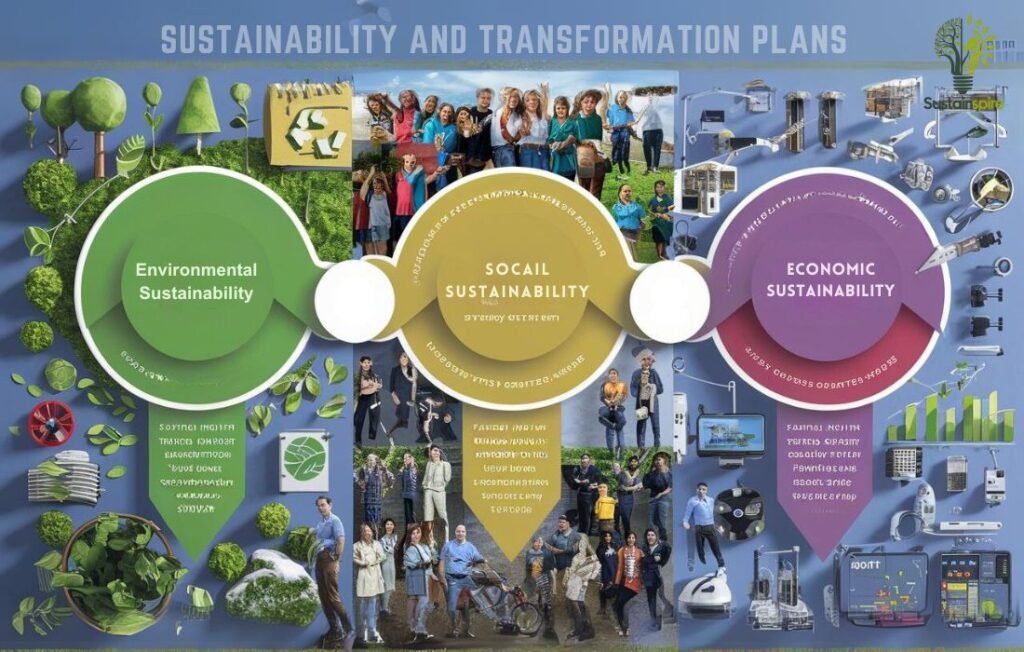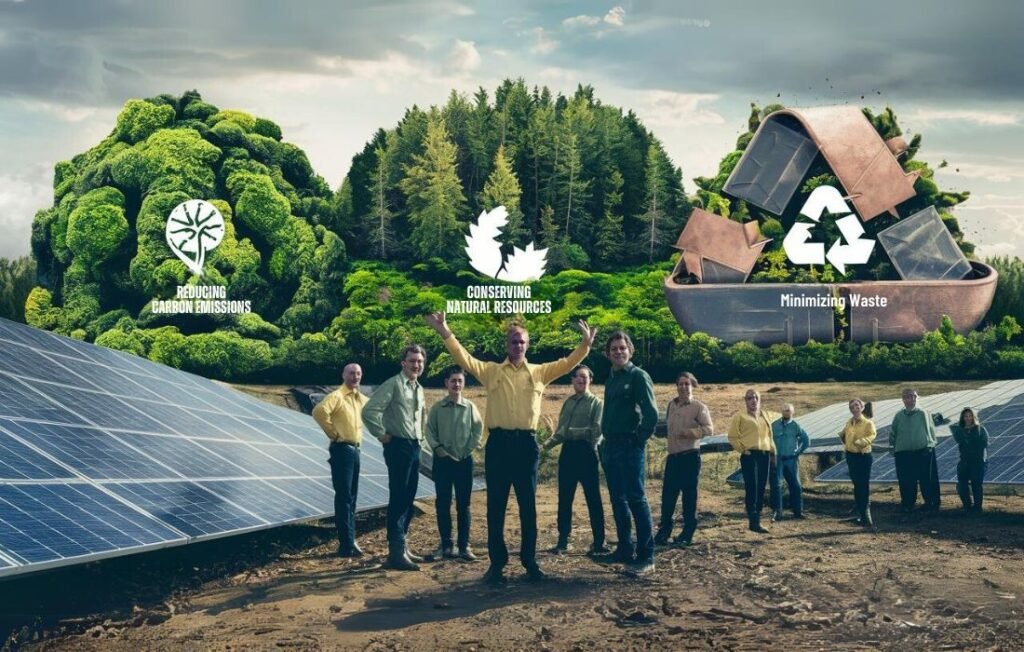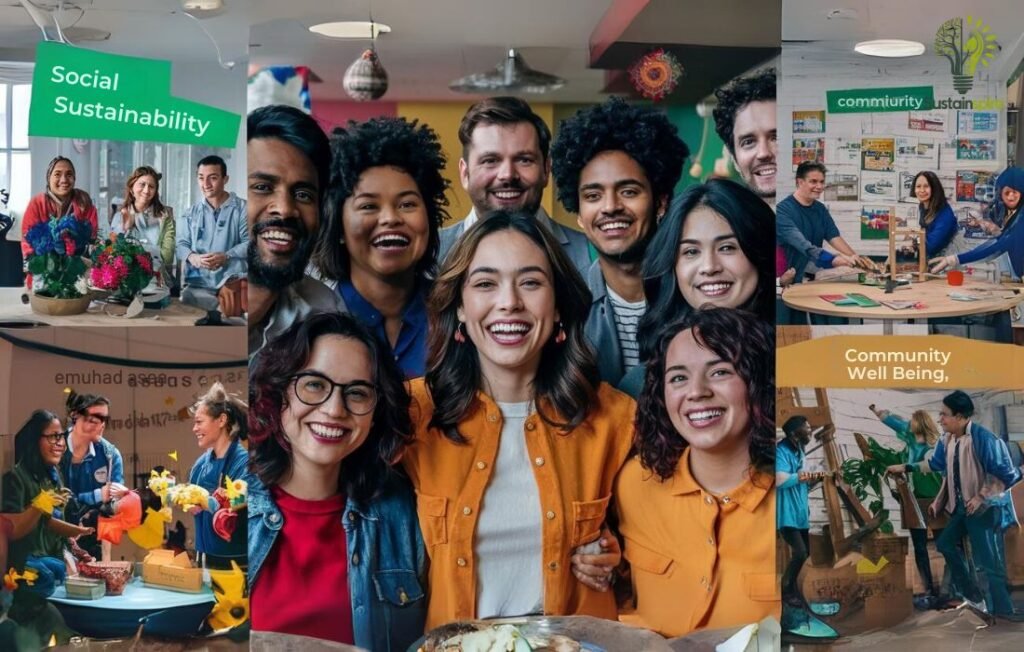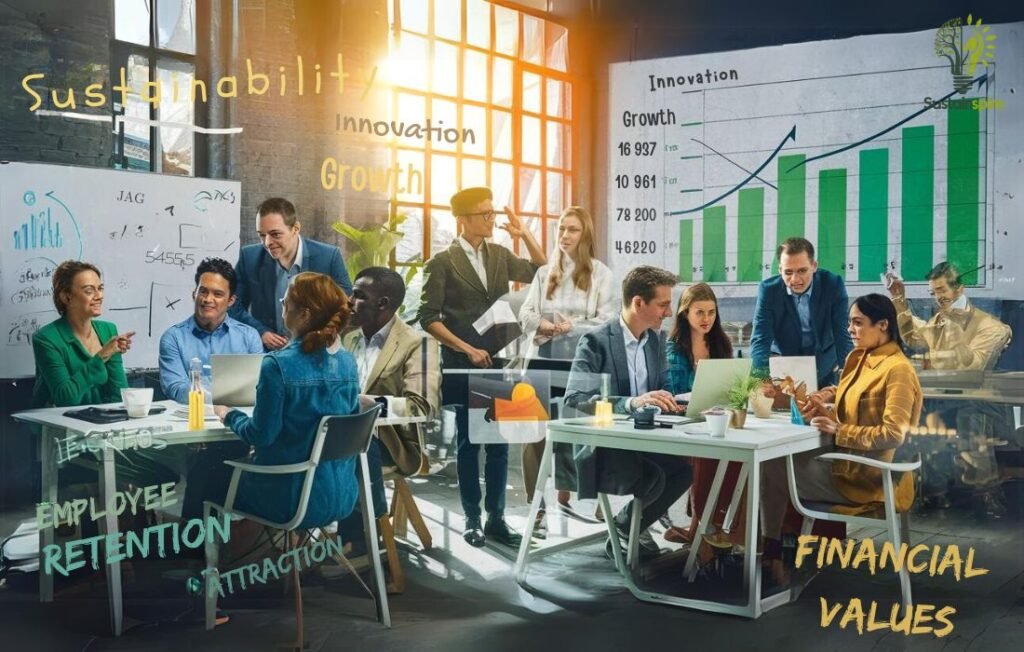Have you ever wondered if your organization’s sustainable transformation plans are truly sustainable? Do you struggle to balance environmental, social, and economic goals in your efforts to transform your organization? If so, you’re not alone! Many organizations grapple with these challenges as they navigate the complex landscape of sustainability.
Sustainable and transformation plans are essential for organizations that seek to thrive in today’s competitive and rapidly changing business environment. These plans provide a roadmap for organizations to transition toward a more sustainable and resilient future. However, creating and implementing effective sustainability and transformation plans is often a daunting task, requiring a deep understanding of the complexities and interdependencies within organizations and their external environments.
This guide will provide you with all the tools and knowledge you need to create and implement a successful sustainable transformation plan. By the end of this guide, you will have a clear understanding of the key components of a sustainable transformation plan, the challenges you may face, and the benefits you can expect. So, what are you waiting for? Let’s get started on creating a sustainable future for your organization!
What is Sustainable Transformation?
Sustainable transformation is the process of changing an organization or system in a way that is both environmentally and socially responsible. This means considering the long-term impact of changes on the environment, society, and the economy. Sustainable transformation is not just about making changes that are good for the environment, but also about making changes that are good for the organization or system in the long run.
For example, a company might implement a sustainable transformation plan to reduce its carbon footprint. This could involve switching to renewable energy sources, reducing waste, or improving energy efficiency. These changes would not only help the environment, but they could also save the company money in the long run.
Why is Sustainability Important within Transformation Plans?
There are many reasons why sustainability is important within transformation plans. First, sustainability is essential for the long-term success of any organization or system. By considering the long-term impact of changes, organizations, and systems can make decisions that will benefit them in the future. Second, sustainability is increasingly important to customers and stakeholders. Consumers are increasingly demanding products and services that are produced sustainably. Third, sustainability is a key driver of innovation. By focusing on sustainability, organizations, and systems can create new products and services that meet the needs of the future.
Key Elements of Effective Sustainable and Transformation Plans

Sustainable and Transformation Plans (STPs) are essential for organizations looking to create a more sustainable and prosperous future. Effective STPs should focus on three key pillars: environmental sustainability, social sustainability, and economic sustainability.
Environmental sustainability
Environmental sustainability is a critical component of sustainable development. It ensures that our planet’s resources are preserved for future generations while meeting current needs. Three key elements of environmental sustainability are:

- Reducing Carbon Emissions: Carbon emissions primarily come from fossil fuel usage. By embracing renewable energy sources like solar and wind power, we can significantly reduce greenhouse gas emissions and combat climate change.
- Conserving Natural Resources: Indiscriminately extracting and exploiting natural resources leads to depletion. Practicing sustainable farming, using energy-efficient appliances, and recycling help conserve water, forests, and other valuable resources.
- Minimizing Waste: Excessive waste generation not only depletes resources but also harms the environment. Implementing the “3Rs” – reduce, reuse, and recycle – can significantly reduce waste and promote a circular economy.
Social Sustainability
Social sustainability is a vital aspect of sustainable development that focuses on promoting social equity, diversity, and well-being. It aims to create a just and inclusive society where everyone has an equal opportunity to thrive.

- Improving Workplace Equity and Diversity: Creating a diverse and equitable workplace is crucial for social sustainability. By fostering an inclusive environment that values all employees regardless of race, gender, sexual orientation, or other factors, organizations can unleash the full potential of their workforce and enhance innovation.
- Supporting Local Communities: Businesses can contribute to social sustainability by supporting local communities through various initiatives. Engaging with local organizations, providing job opportunities, and investing in community development projects can strengthen social bonds and create mutual benefits.
- Enhancing Employee Well-being: Happy and healthy employees are the backbone of a sustainable organization. By investing in employee well-being programs, such as flexible work arrangements, wellness initiatives, and mental health support, companies can reduce stress, improve employee morale, and foster a positive work environment.
Remember, social sustainability is not just about being nice, it’s about building a better future for all! By embracing these principles, organizations can make a meaningful impact on their employees, communities, and the world at large.
Economic Sustainability
Economic sustainability ensures the long-term financial health and growth of a business or organization. It encompasses strategies and practices that promote financial stability, innovation, and employee engagement.

- Generating Long-Term Financial Value: Economic sustainability aims to generate and preserve financial resources for the future. This involves responsible financial management, including maximizing revenue streams, minimizing expenses, and building financial reserves. By creating a solid financial foundation, businesses can weather economic downturns and continue to invest in their operations and growth.
- Fostering Innovation and Growth: Economic sustainability encourages innovation by providing resources and incentives for research and development, product development, and expansion into new markets. Sustainable businesses recognize the importance of staying ahead of the competition and adapting to changing market trends.
- Ensuring Employee Retention and Attraction: Economic sustainability supports employee engagement and retention by providing competitive compensation, benefits, and opportunities for growth. A stable financial environment enhances employee morale, reduces turnover, and attracts top talent. Satisfied employees contribute to greater productivity, innovation, and customer satisfaction.
Economic sustainability is crucial for the long-term success of businesses and organizations. By prioritizing financial stability, fostering innovation, and valuing employees, organizations can establish a solid economic foundation that supports their mission and enhances their impact.
Developing a Comprehensive Plan – One of Sustainable and Transformation Plans
Sustainable and Transformation Plans (STPs) provide a roadmap for healthcare organizations to navigate the evolving healthcare landscape. A well-crafted STP sets the foundation for success by establishing clear goals and objectives, identifying key stakeholders, conducting a thorough sustainability assessment, developing actionable strategies, and implementing a robust monitoring system.
Setting Clear Goals and Objectives
Establishing clear and concise goals and objectives is paramount in crafting an effective Sustainability and Transformation Plan. These targets should align with the organization’s overall mission, vision, and values. They should be specific, measurable, achievable, relevant, and time-bound (SMART) to ensure they are actionable and facilitate progress tracking.
Identifying Key Stakeholders
Engaging key stakeholders throughout the development and implementation of the plan is crucial. These individuals or groups can include employees, customers, suppliers, investors, and community members. Understanding their perspectives and soliciting their input will foster collaboration, increase buy-in, and enhance the plan’s success.
Conducting a Sustainability Assessment
A comprehensive sustainability assessment provides a baseline from which to develop the plan. This assessment should evaluate the organization’s environmental, social, and economic impacts and identify areas for improvement. It should also consider industry best practices and emerging sustainability trends.
Developing Actionable Strategies
The plan should outline specific strategies for achieving the established goals and objectives. These strategies should be grounded in the findings of the sustainability assessment and should consider the organization’s capabilities and resources. They should also include clear timelines, responsibilities, and performance indicators to monitor progress.
Implementing and Monitoring Progress
Effective implementation of the plan requires dedicated resources and regular monitoring. Establishing a monitoring framework with key performance indicators (KPIs) will allow the organization to track progress towards its goals and make necessary adjustments along the way. Regular reporting and communication will ensure that stakeholders are informed of the plan’s progress and its impact on the organization and its stakeholders.
Best Practices for Transformation Success
Following are a few practices for Sustainable and Transformation Plans success:
1. Employee Engagement:
Engaging employees in sustainability efforts is crucial for successful transformation. Communicating the significance of sustainability, empowering employees to take action, and recognizing their contributions can foster a culture of environmental consciousness.
Communicating the Importance of Sustainability
- Educate employees: Conduct workshops, seminars, and training sessions to enhance their understanding of sustainability and its impact on the organization and the world.
- Set clear goals: Establish tangible sustainability targets to provide employees with a sense of purpose and direction.
- Share success stories: Highlight the positive outcomes of past sustainability initiatives to motivate and inspire employees.
Empowering Employees to Take Action
Provide opportunities: Offer employees roles and responsibilities within sustainability programs, such as green teams or energy conservation initiatives.
- Foster innovation: Encourage employees to contribute ideas and solutions to address sustainability challenges.
- Create a supportive environment: Provide resources, support, and mentorship to empower employees in their sustainability efforts.
Recognizing and Rewarding Sustainability Efforts
- Acknowledge achievements: Recognize and celebrate employee participation and contributions to sustainability initiatives.
- Offer incentives: Provide incentives, such as rewards or bonuses, for exceeding sustainability goals.
- Promote employee sustainability champions: Identify and showcase employees who go above and beyond in their sustainability efforts. By engaging employees in sustainability transformation, organizations can create a workforce that is passionate about environmental stewardship and committed to driving positive change.
2. Data-Driven Decision-Making
The Backbone of Sustainability and Transformation Plans. Data-driven decision-making is no longer a buzzword; it’s a necessity for organizations navigating the complex landscape of sustainability and transformation. By gathering and analyzing relevant data, businesses can make informed decisions, track progress, and adjust plans based on tangible insights.
Collecting and Analyzing Relevant Data for Sustainable and Transformation Plans
- Identify key metrics: Define the specific performance indicators that will measure progress towards your sustainability and transformation goals.
- Gather diverse data: Collect data from various sources, including internal operations, customer feedback, industry benchmarks, and environmental assessments.
- Data quality is key: Ensure the data collected is accurate, reliable, and consistent to support informed decision-making.
- Embrace technology: Leverage data analytics tools and software to streamline the data analysis process and extract meaningful insights.
Using Data to Inform Strategy and Track Progress
- Set targets: Establish clear and measurable goals aligned with your sustainability and transformation objectives.
- Develop data-driven strategies: Use data to identify areas for improvement, prioritize initiatives, and allocate resources effectively.
- Monitor performance: Regularly review data to track progress against targets and identify areas where adjustments may be necessary.
Adjusting Plans Based on Data Insights
- Be agile: Data-driven decision-making allows for flexibility. When data indicates a need for course correction, don’t be afraid to adjust plans accordingly.
- Embrace continuous improvement: Use data to identify areas for continuous improvement and refine your sustainability and transformation strategies.
- Communicate data-driven decisions: Inform stakeholders of the data insights and the rationale behind the decisions made.
Remember, data-driven decision-making is not just about crunching numbers; it’s about gaining actionable insights that drive meaningful change and transform your organization into a sustainable and thriving enterprise.
Overcoming Challenges in Sustainable Transformation
Sustainable transformation is a complex and challenging process, but it is essential for organizations that want to survive and thrive in the 21st century. There are a number of challenges that organizations face when trying to transform their operations and become more sustainable. But we can overcome these challenges with ease.
1. Resistance to Change: Addressing Concerns and Communicating Benefits
Overcoming resistance to change is a common obstacle in any sustainability transformation initiative. Employees may feel uncertain about the new processes, technologies, or policies that are being implemented. To effectively address these concerns, it’s essential to:
Communicate the benefits:
Clearly articulate the ways in which the changes will positively impact the organization, employees, and the environment. Use data, success stories, and tangible examples to demonstrate the value of the transformation.
Provide training and support:
Ensure that employees have the knowledge and skills they need to embrace the changes. Offer training programs, workshops, and ongoing support to help them adapt and thrive in the new environment.
Build a culture of innovation:
Foster an open and receptive mindset where employees feel comfortable suggesting new ideas and sharing feedback. Encourage experimentation and risk-taking while providing a safe space for learning and growth.
2. Financial Constraints: Identifying Funding Sources
One of the biggest challenges in sustainable transformation is funding. Sustainability initiatives often require significant upfront investments, which can be daunting for organizations with limited resources. However, there are numerous ways to overcome this challenge:
Identify Funding Sources:
Explore various funding sources, such as government grants, private investors, and impact funds. Research and apply for funding opportunities that align with your sustainability goals.
Prioritize Sustainability Investments:
Allocate resources wisely by prioritizing sustainability initiatives with the highest potential return on investment. Consider the long-term benefits, such as reduced operating costs, improved brand reputation, and increased customer loyalty.
Explore Partnership Opportunities:
Collaborate with external partners, such as non-profit organizations and research institutions, to share costs and leverage their expertise. Joint ventures can provide additional funding and access to resources.
By implementing these strategies, organizations can overcome financial constraints and secure the necessary funding to drive sustainable transformation. Remember, sustainability is not just a cost but also an opportunity for growth and innovation.
Resources and Support for Sustainable Transformations
In today’s rapidly evolving world, organizations are facing increasing pressure to adopt sustainable practices that align with the needs of society and the environment. While this transition can be challenging, numerous resources and support systems are available to assist organizations in navigating this transformative journey.
Government Initiatives and Funding
Governments around the world are increasingly recognizing the importance of Sustainable and Transformation Plans. They are providing financial and other support to businesses and organizations that are committed to making the transition to a more sustainable future. This support can take the form of grants, loans, tax breaks, and other incentives.
For example, the European Union has committed to becoming climate-neutral by 2050 and has launched several initiatives to support businesses in reducing their carbon footprint. These initiatives include the European Green Deal, which provides funding for research and development of sustainable technologies, and the EU Emissions Trading System, which puts a price on carbon emissions.
In the United States, the Biden Administration has made climate change a top priority and has proposed several initiatives to support sustainability, including a $2 trillion infrastructure plan that includes funding for clean energy projects and a Clean Energy Standard that would require utilities to get a certain percentage of their electricity from renewable sources. The US government has established several programs and initiatives to promote sustainable practices and transformations.
- The Environmental Protection Agency (EPA) offers grants and funding opportunities for projects related to pollution prevention, clean energy, and climate change mitigation.
- The Department of Energy (DOE) provides support for research and development of renewable energy technologies, energy efficiency measures, and advanced transportation systems.
- The US Department of Agriculture (USDA) offers programs to support sustainable agriculture practices, including conservation tillage, nutrient management, and organic farming.
Nonprofit Organizations and Sustainability Consultancies
Numerous nonprofit organizations and sustainability consultancies provide resources and support for businesses looking to adopt sustainable practices. The Nature Conservancy offers guidance on developing and implementing sustainability plans, conducting environmental assessments, and measuring progress towards sustainability goals.
World Wildlife Fund (WWF) provides tools and resources for businesses to reduce their environmental footprint, promote sustainable supply chains, and engage with stakeholders on sustainability issues. WWF works with businesses and organizations to develop and implement sustainability strategies, focusing on conservation, climate change mitigation, and responsible sourcing.
Sustainability consultancies like ERM and AECOM offer a range of services to help organizations develop and implement sustainability strategies, including sustainability audits, greenhouse gas accounting, and life cycle assessments. Climate Works Foundation supports research and advocacy for climate action, providing resources and funding to accelerate the transition to a low-carbon economy.
Industry Best Practices and Case Studies
Many businesses have successfully implemented sustainability initiatives and achieved significant results.
- Patagonia, an outdoor apparel company, has a long history of environmental stewardship and has implemented a range of sustainable practices, including using recycled materials, reducing waste, and promoting ethical manufacturing.
- Walmart, the world’s largest retailer, has set ambitious sustainability goals and has made significant progress in reducing its carbon footprint, increasing energy efficiency, and promoting sustainable products.
- Unilever, a multinational consumer goods company, has developed a sustainable living plan that includes reducing its environmental impact, improving health and well-being, and promoting social progress.
- Toyota’s comprehensive sustainability report showcases the company’s long-standing commitment to environmental stewardship, social responsibility, and economic performance.
- Interface, a flooring manufacturer, has embarked on a mission to eliminate its environmental footprint by 2020, providing a compelling example of sustainable innovation.
- Unilever’s long-term plan focuses on reducing its environmental impact, improving health and well-being, and sourcing sustainably.
These resources and examples provide organizations with the necessary support and inspiration to embark on their sustainable transformation journeys. By leveraging these resources, businesses can drive positive change and create a more sustainable future for all.
Sustainable Transformation in Different Sectors
The drive towards sustainability is reshaping various sectors globally, and businesses are recognizing the importance of integrating sustainability into their operations. Here are some examples of sustainable transformation across different industries:
- Manufacturing: Embracing circular economy principles, manufacturers are reducing waste and conserving resources. BMW has launched a “closed-loop” recycling program for electric vehicle batteries, ensuring they are recycled and reused.
- Healthcare: Hospitals and clinics are adopting sustainable practices to reduce environmental impact. Kaiser Permanente has set a goal to become “carbon negative” by 2030, focusing on energy efficiency and renewable energy sources.
- Education: Universities and schools are incorporating sustainability into curricula and campus operations. Stanford University has established a “Sustainability Accelerator” to support research and innovation in this area.
- Financial Services: Banks and investment firms are aligning their portfolios with environmental, social, and governance (ESG) criteria. BlackRock has pledged to “invest sustainably” and engage with companies on climate-related risks.
These examples illustrate how organizations in various sectors are embracing sustainability as a transformative force, driving innovation, reducing environmental impact, and creating long-term value.
Conclusion:
To conclude, sustainable and transformation plans provide a roadmap for businesses to reimagine their operations, reduce their environmental impact, and create a positive and lasting impact on the world. By embracing these plans, organizations can harness the key benefits of increased resilience, enhanced competitiveness, and operational efficiency.
Senior leaders have a crucial role to play in driving this transformation. They must foster a culture of innovation, collaboration, and accountability. By partnering with stakeholders, accessing available resources, and leveraging support systems, businesses can overcome the challenges associated with sustainable transformation and unlock its full potential.
We encourage you to take the next step towards sustainability by engaging with industry experts, exploring case studies, and seeking support from organizations dedicated to promoting sustainable practices. Share your insights, experiences, and challenges to contribute to the collective knowledge and drive progress toward a more sustainable and equitable future. Let’s collectively embark on a bold and transformative journey that will reshape the business landscape and create a legacy that generations to come will be proud of.
Implementing sustainability initiatives requires overcoming challenges such as organizational resistance, lack of employee buy-in, limited resources, and the complexity of integrating sustainability into operations.
Communicate the rationale and benefits of sustainability, involve employees in decision-making, provide training and development opportunities, recognize and reward contributions, and foster a culture of accountability.
Relevant data may include energy consumption, waste generation, water usage, employee engagement, supplier sustainability practices, and customer satisfaction with sustainable products or services.
Explore government incentives, grants, and partnerships with organizations that provide funding for sustainability projects. Consider long-term savings from reduced energy costs, improved resource efficiency, and enhanced brand reputation.
Consult industry associations, government agencies, non-profit organizations, and sustainability consultants for expertise, best practices, and access to funding opportunities.








3 thoughts on “The Ultimate Guide to Sustainable and Transformation Plans”